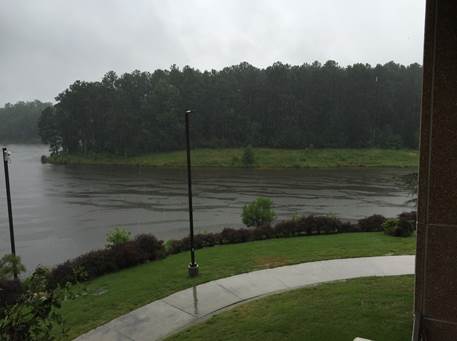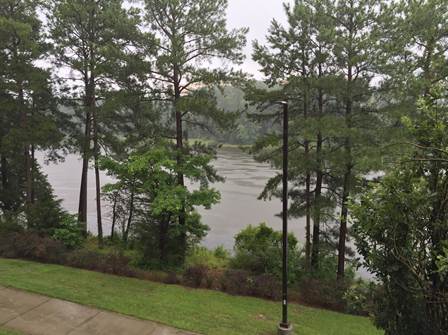Discovery Lake Shares a Moment of Wonder
Discovery Lake Shares a Moment of Wonder
By Bill Willis, SET and Kyle Hawkins, RTPFMB
July 6, 2016

Photo courtesy of Kyle Hawkins
Discovery Lake offered up a head shaking, head scratching moment on Tuesday, June 21, 2016 around lunchtime, producing a scene that hadn’t been witnessed here. In the midst of a substantial rain event, the entire lake surface became patterned as if some unseen force had created channels in the water. There were darker streaks winding through lighter more textured areas. But what caused the surface to look this way and why? No geese or carp could be seen, the winds were calm, and the rain was steady, yet these patterns persisted for well over an hour.
There had to be a plausible reason. An employee, hearing the discussion, said that he had seen a similar event while boating on the Great Lakes, but from a boat, never from shore. He had no further explanation.
It appeared that the surface tension was different across the lake, but why would that be? A search of the World Wide Web, produced only one article and discussion that might explain this phenomenon. The author states the following, which sounds very similar to what we had observed.

Photo courtesy of Kyle Hawkins
“The (lake) patterns are always seen when it is raining and the wind is either light or absent. The raindrops hitting the Lake’s surface produce ripples, which then flow out from the spot of impact. In the absence of the larger wind–produced waves, the myriad of ripples produce a textured surface, one with an almost granular appearance. But, why is this granular texture greatly diminished in some regions? After all, the rain is falling everywhere and so ripples are being produced equally everywhere.”
“Ripples are somewhat unlike the waves produced by the wind or a boat. For those big waves, the restoring force is gravity. For the ripples (also known as capillary waves), the restoring force is (the water’s) surface tension.”
While water in a small lake may seem to be still, currents exist within these bodies of water. Currents may exist due to water flow from the stream inlets / outlets of the lake, wind flows or convection. Because of the various sources of currents, the author goes on to say “the water in a lake does not merely flow horizontally. There are regions where the water gently rises to the surface (upwelling) and spreads out (divergence). There are regions where the surface water flows together (convergence) and sinks (down welling).”
“Surfactants suppress ripples in regions of surface convergence. A surfactant is something on the water—usually small quantities of natural organic material from plants or algae—that alters surface tension. A surfactant reduces surface tension and so inhibits the formation of the ripples that gives the rained–on water the granular appearance. So, in regions containing a surfactant, the water will look calmer.” The Site Ecology Team had noted that the lake had a surface film several days last week made up of decaying algae, bacteria and protozoans.
“Outflow impedes ripples from entering regions of surface divergence. For the patterns seen in the rain, the divergent flow of upwelling regions is more interesting. Ripples, which form in that region, can flow out into the surrounding region, but ripples which form outside the region are impeded from flowing in to it by the mere fact that the ripples must travel against the current of the spreading water. So, by this mechanism, one would expect the regions of upwelling to be smoother. The fairly sharp boundary is the place where the outflow velocity matches the ripple velocity.”
This sounds somewhat technical but a feasible explanation for this phenomenon, because all the weather factors including a surfactant source (algae, bacteria) film were in place that day. If you have insight into this phenomenon or personal experiences, please let us know.
A special thanks to Kyle Hawkins for pictures and helping prepare this article.



